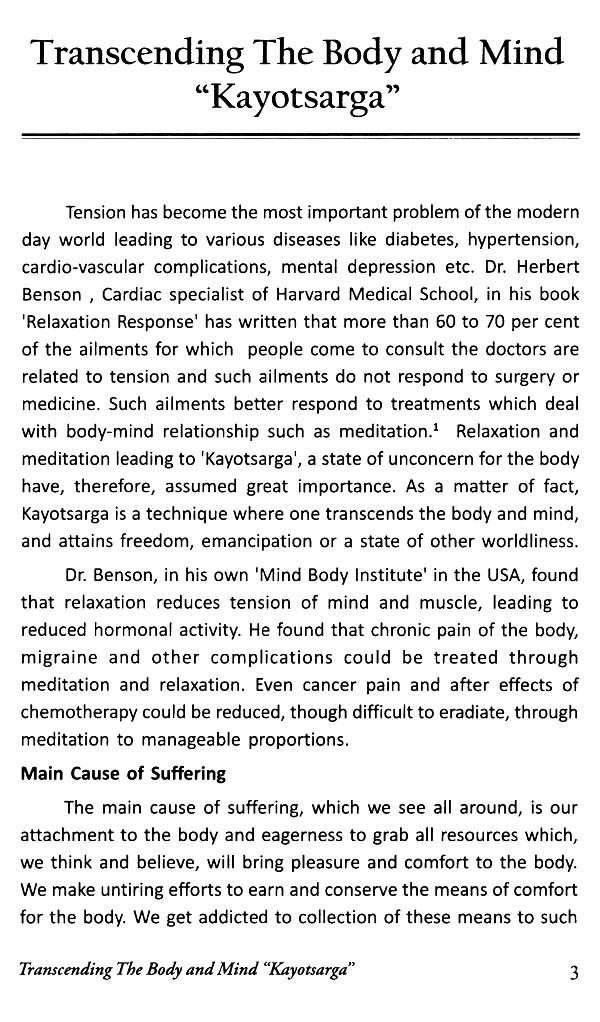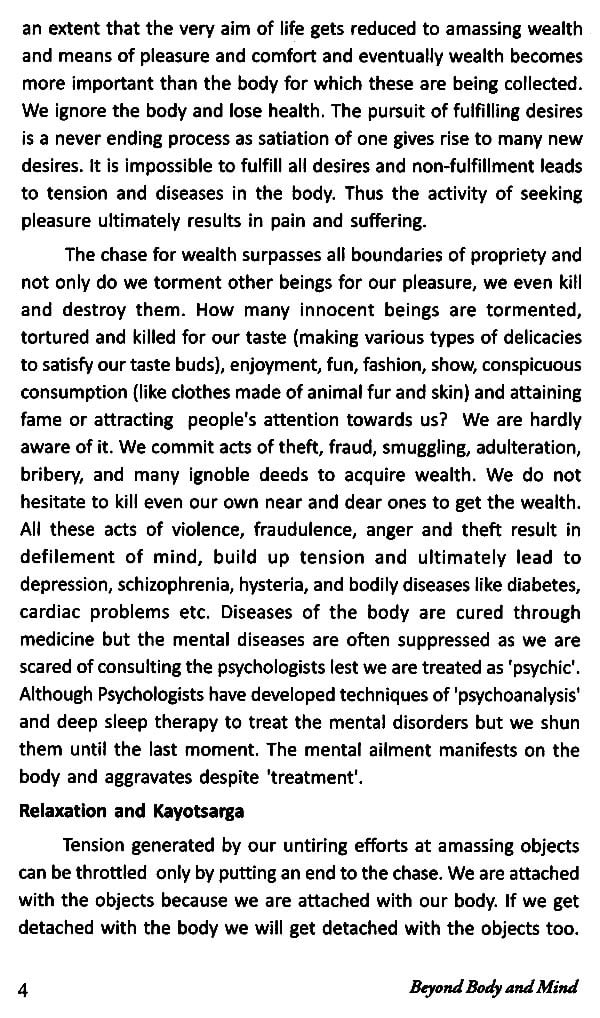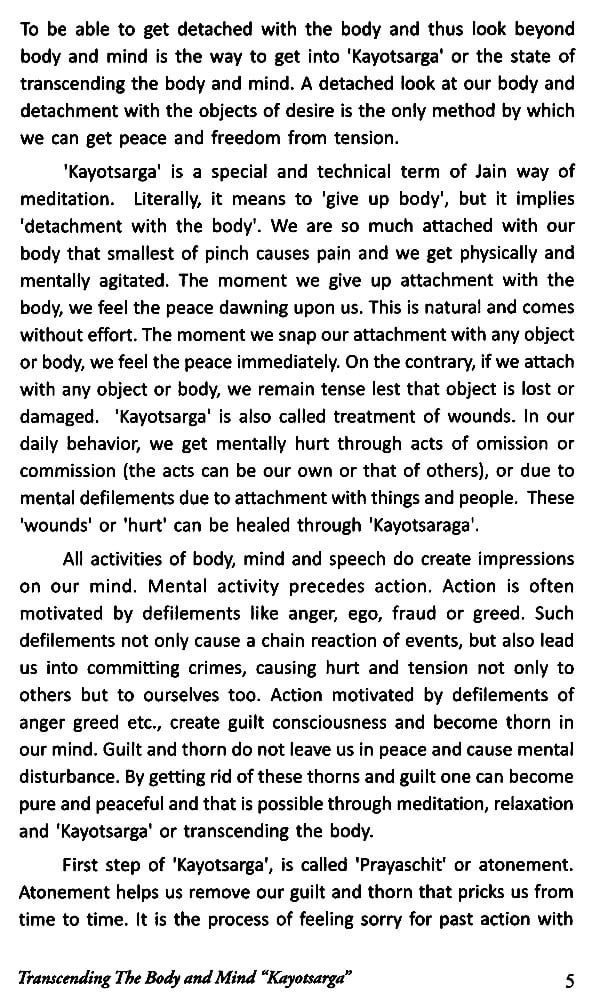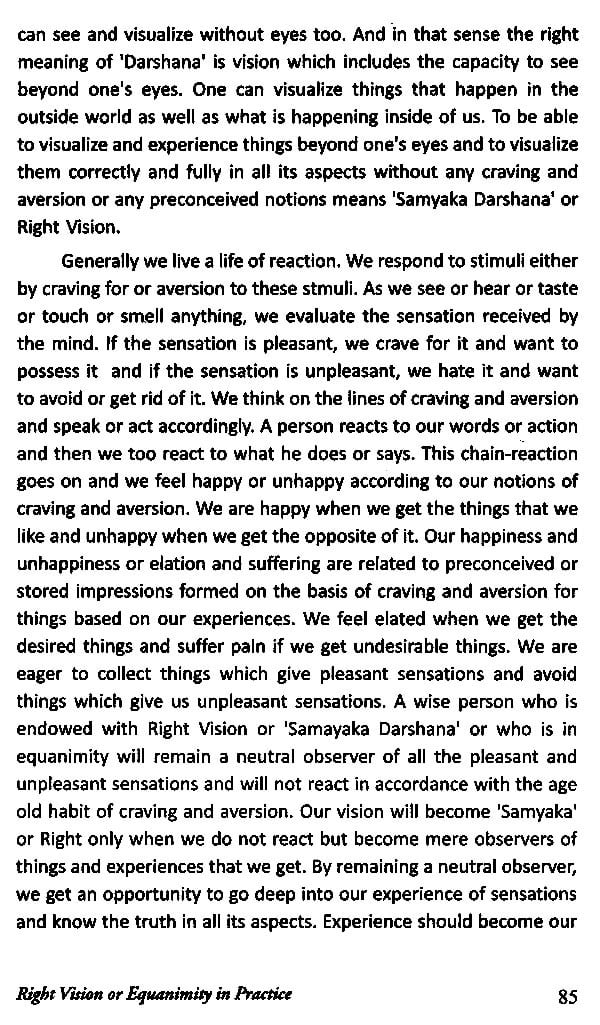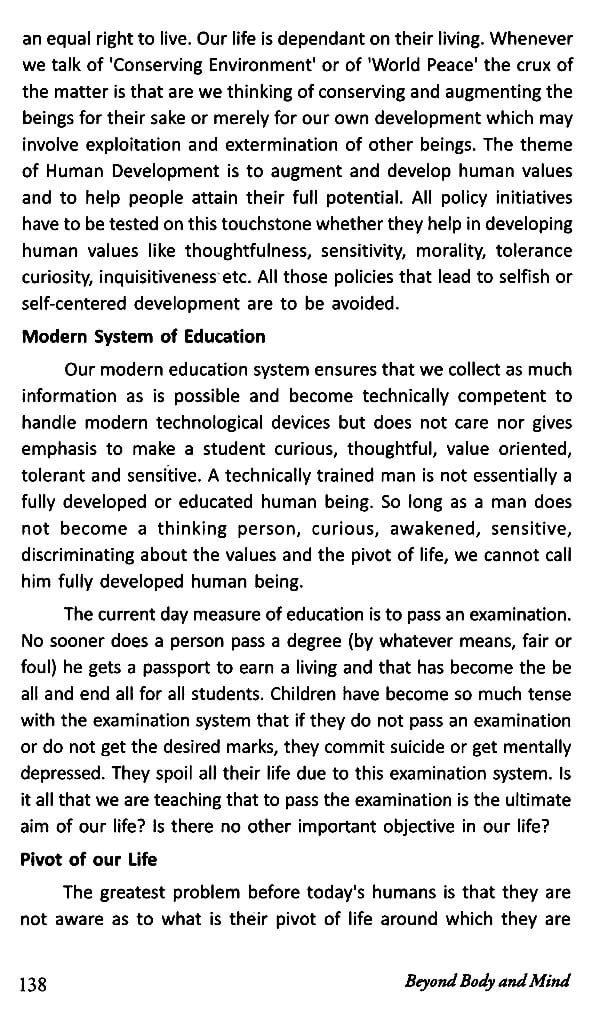
Beyond Body and Mind
Book Specification
| Item Code: | UAB905 |
| Author: | Ranjit Singh Kumat |
| Publisher: | Prakrit Bharati Academy, Jaipur |
| Language: | English |
| Edition: | 2014 |
| ISBN: | 9789381571408 |
| Pages: | 173 |
| Cover: | PAPERBACK |
| Other Details | 8.50X5.50 inch Depth |
| Weight | 200 gm |
Book Description
Born in 1938 in Bijainagar (Ajmer district of Rajasthan), did his M.A. in Economics from Delhi School of Economics in 1959, and after a short stint of teaching in Delhi University, joined the IAS in 1962.
Worked on various important posts of the Government of Rajasthan such as Collector and District Magistrate of Ajmer, Jaipur and Jhalawar districts, Director of Education, Secretary of important departments like Education, Medical and Health, Revenue, Rural Development and CEO of important Public Sector Organisations like Rajasthan Co-operative Dairy Federation, Jaipur Metals and Electricals, and finally retired in November 1995, from the post of Chairman, Board of Revenue, Ajmer.
Got training at University of Bradford (UK), in 1977, negotiated project on Blindness control in Rajasthan with the World Bank in USA in 1994. Had an impeccable image of honest, hardworking officer with sympathy and deep concern for the poor. Associated with many philanthropic and civil society institutions and worked as Apex President of Mahavir International, Jaipur, President of Rajasthan Adult Education Association, Jaipur, and Chief Commissioner of Rajasthan Bharat Scouts and Guides and received award of 'Silver Elephant' from the President for Scouts and Guides. Founded Mahavir Smarak Sewa Samiti at Ajmer in 1975 and Vardhaman Smarak Sewa Samiti at Jaipur in 1976 for the benefit of students and the poor people.
Studied Jain Scriptures, and attended meditation camps of Vipassana. His first book 'Mujhe Moksha Nahin Chahiye' (I do not want Salvation), published in 1988, surprised most readers but was welcomed as refreshing interpretation of Jain Sutra with message for practical life to shed rituals and realise the True Dhamma. His second book 'Deha our Man se Pare' in Hindi, published in 2004, was acclaimed as a landmark in interpretation of various traditional Jain practices like Pratikraman, Kayotsarga, Samlekhana and sutras of Aachaaraanga Sutta in a novel and refreshing manner. His next book 'Self Awareness through Meditation' in English and 'Dhyaana se Swabodha' in Hindi were published in 2007. This is a comparative study of Jain, Buddha, and Patanjali's systems of Meditation. According to Dr. L.M. Singhvi, former High Commissioner of India to UK, the book is a significant contribution to the field of 'Science of Consciousness and Art of Living' and commends meditation to attain self awareness so as to live a life of 'free man' without waiting for salvation or redemption after death. His writings are "readable, engaging, lucid, instructive, educative, enlightening and edifying. His views are patently practical, based on his personal experience and learning".
Shri Ranjit Singh Kumat's image as an author of his earlier book 'Mujhe Moksha Nahin Chahiye' (I do not want Salvation) as thinker and elucidator has been reinforced, confirmed and edified in his new book "Beyond Body And Mind" (Doha Aur Man Se Pare). Present book is the essence of Shri Kumat's deep study, thought and learning. Shri Kumat has decorated the book with numerous precious jewels of the philosophy lying in the bottomless ocean of Jain Wisdom.
In the past numerous millenniums, deep thinking has been going on in the 'Shraman' as well as Vedic traditions about the 'Way of Living' and 'Philosophy of Life' and in these two streams as well as other numerous sub-streams of thought, a philosophy of life representing Indian thought and endeavour has emerged as a lotus of internal coordination and easy harmonization, universally accepted as the most valuable heritage of Indian Philosophy of Living. This book goes in the depth of scriptures and principles, and elucidates contemporary and practical meaning of that thoughtful endeavour and philosophy of life, highlighting the real truth relevant to modern life in a balanced manner.
To experience transcendental consciousness and emancipation while living in the body, Shri Kumat suggests and analyses the practice of relaxation and 'Kayotsarga'. Defining 'Kayotsarga' the learned author says, "To be able to get detached with the body and thus look beyond body and mind is the way to get into 'Kayotsarga' or the state of transcending the body and mind. The author explains that though Kayotsarga literally means to 'give up body', but it actually means 'detachment with the body'. 'Kayotsarga' is also called treatment of wounds as we are able to remove the thorny hurts of our subconscious mind. In Kayotsarga, the conscious mind as also the body gets relaxed. The subconscious mind, however, remains active and the stored impressions surface on the body and one can become a silent and careful observer of one's thoughts, emotions and anxiety without any reaction. The author earns special credit for presenting the process of Kayotsarga in easily understandable words. Similarly, the explanation of the process of 'Pratikraman' or Retreat is author's superb presentation. The author has presented a well thought out essay on the concept, tradition and practice of 'Pratikramana' or Retreat In the present book. Similarly, discussing the concept of 'Samlekhanaa', the learned author defines it as "observing the self with equanimity". He has propounded the view that "a grave mistake has occurred in regarding Samlekhanaa as the practice prescribed for the last leg of one's life. This endeavour envisages daily introspection and observation of the self - the body, thoughts and emotions; it is the way of self-observation. It is author's humble submission that the endeavour of Samlekhanaa is not merely an endeavour of the last days of one's life; it is a daily endeavour and will help in achieving the ultimate freedom or 'Sidhattava'. From this angle the viewpoint of the author needs close scrutiny when he says, "To be able to see 'death' in life before the actual death is real 'Samlekhanaa'. One should not wait for the death that may come at the end stage of life. As a matter of fact one is never sure as to when it would come. One should regard death as an unpredictable event and coming any moment and regard the body, things and worldly riches as ephemeral and impermanent. To be able to see this impermanence and 'death' in all things is ‘Lekahnaa’ or to see the truth. To see the truth with equanimity is 'Samlekhanaa". If we die in a state when we are seeing the truth with equanimity, it is the best type of death that one can wish for leading to 'Siddhatva'. What is 'Siddhatava'? "When there Is no work unfinished or no desire unfulfilled, the state of infinite and everlasting bliss. When the root cause of suffering-desire-ends, the state of infinite and eternal bliss starts. That is the state of Mukti, eternal freedom or 'Siddhatava'.
Essays on Meditation and Vipassana are in the same line of thought, connected with Shramana tradition and can be linked and identified with Pratikraman, Vipassana, Dhyana, and Samlekhanaa. The learned author in his essay on Aachaaraanga Sutta has brought out how the different systems of endeavour like lain, Buddha, Saankhya and Yoga were inter-related and intertwined.
One chapter of this book needs special mention. My reference is to the essay on 'Yoga: Jaina and Vedic' which brings out in-depth comparative study of the two systems. While referring to the book of Hemachandr acharya, the author has brought out as to how the 'Chitta Vritti Nirodh' (control of proclivity of mind) in the Patanjali Yoga Shastra is similar to 'Yoga Nigrah' (control of Yoga signifying mind, body and speech) propounded in the Jain tradition.
This is a translation of my book in Hindi titled 'Deha Aur Man se Pare' (Beyond Body and Mind). The book in Hindi, published in 2004, was a compilation of my articles published in various magazines from time to time. The book is divided in two parts. The first part deals with practices of Jain system like `Kayotsaraga"(Transcending the Body),'Pratikramana' (Retreat) and 'Sanlekhana' (to observe with Equanimity), as also on meditation both in Jain system and in Buddha system designed and developed to go beyond body and mind and experience the transcendental stage, an ethereal experience beyond the reach of the sense organs.
At the physical level we know what sensations are good and what are unpleasant for the body and accordingly we seek the pleasant ones and avoid the unpleasant ones. This process becomes our lifelong habit and most part of our life is spent in craving and aversion. We hardly know what is beyond bodily pleasures and pains and can hardly perceive beyond the thinking mind Being attached to our body and mind, we have limitation in experiencing anything other than bodily pains and pleasures. We seek bodily pleasures but when instead pain strikes, we get perturbed and search the ways to ward it off, little realising that pain and pleasure are obverse and reverse of the same coin. Making a choice between pain and pleasure and attempting to retain the pleasure and eradicate the pain indicates intense attachment with the body and the deep rooted habit of craving and aversion for pleasure and pain. If one has to go beyond body and mind, one has to rise above the bodily pleasures and pains and stop craving for 'what is not' and make full use of 'what is'. In other words, freeing oneself from the bondage of bodily pleasures and suffering, neither craving for the bodily pleasures nor fearing the suffering or pain, is the true and real picture of perfectly happy and blissful life, called Liberation or Mukti. One should be able to experience this state in this life itself or else what is the fun of getting Moksha after death?
"Desire" is the greatest obstacle in leading a liberated life. We take birth to fulfill the desires we host in our mind and this keeps the chain of birth and death going endlessly. We put in all our energy in fulfilling the unending circle of insatiable 'desires', and often get ill due to overexertion and stress on body and mind. Stress and anxiety bring pain, suffering, disease etc., and then blame is put on 'Karma' or some outside agency like society, God etc. The real cause of suffering is the non-fulfilment of desire. As a matter of fact, we consider fulfilment of desire as the fulfilment of 'self' and so the aim of life becomes fulfilment of all 'my desires'. 'Me' and 'Myself' and 'I' become the centre of the 'world'. This is the ego or the self around which everything must revolve. The moment we disassociate with 'desires', the ego dissolves and though we continue to live in this body, we transcend the body and mind. The key effort for liberation is thus to liberate oneself from desires.
There are four chapters on the theory of Karma as to how they are created, stored, and exhausted. There is misconception about the theory of Karma and many unwarranted interpretations have crept in. Every action is considered as 'Karma' which binds us whereas only those actions become 'Karma' which are motivated by 'kashaya' or ill will like greed, anger, deceit and ego. Each action has its own reaction but the manner and timing of retribution is governed by the 'kashaya' or ill will that motivated that action.
Second part of the book relates to 'Human Development' or self development. Normally 'Human Development' is indexed and measured by the statistics of per capita income, literacy, housing, basic minimum needs and health whereas, in reality, it means full blooming of the potential of human personality which includes the development of human attributes like human values, character, inquisitiveness, thinking, sensitivity, tolerance, awareness etc. Spiritual development or Dhamma has special significance in 'Human Development'. However, the moment we talk of 'spirituality' or Dhamma or religion, people get scared as spirituality or religion is always linked to some religion or sect which is often the source of communal tangles.
Spirituality is often associated with visit to temple, Gurudwara, Mosque or Church or worship for a given period at home or any designated religious place. This is considered separate and distinct from daily activities of routine work at home or workplace. What and how we earn our bread or have relationship in family or workplace is not supposed to have any connection with 'religion'. This dichotomy between religion or spirituality and the work or secular life has done great harm and our life of earning bread or living life in family is disconnected with eternal principles of spiritual values and thus our life is divided and disintegrated. Even the Government has failed to see the difference between Dhamma and sect and in the name of secularism all systems including education have been kept bereft of values and spirituality. We are turning away from the rich culture of values and spiritualism and heading towards value-less society. Modern Education is turning out professionals and technicians but not the humans.
**Contents and Sample Pages**